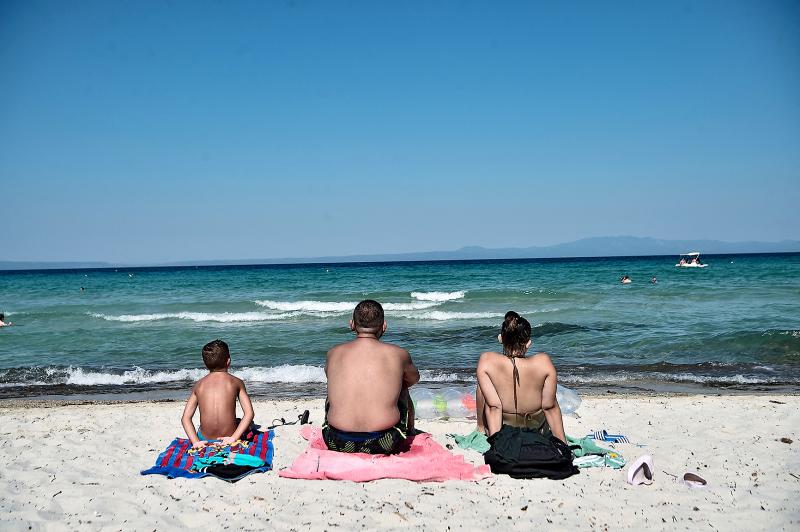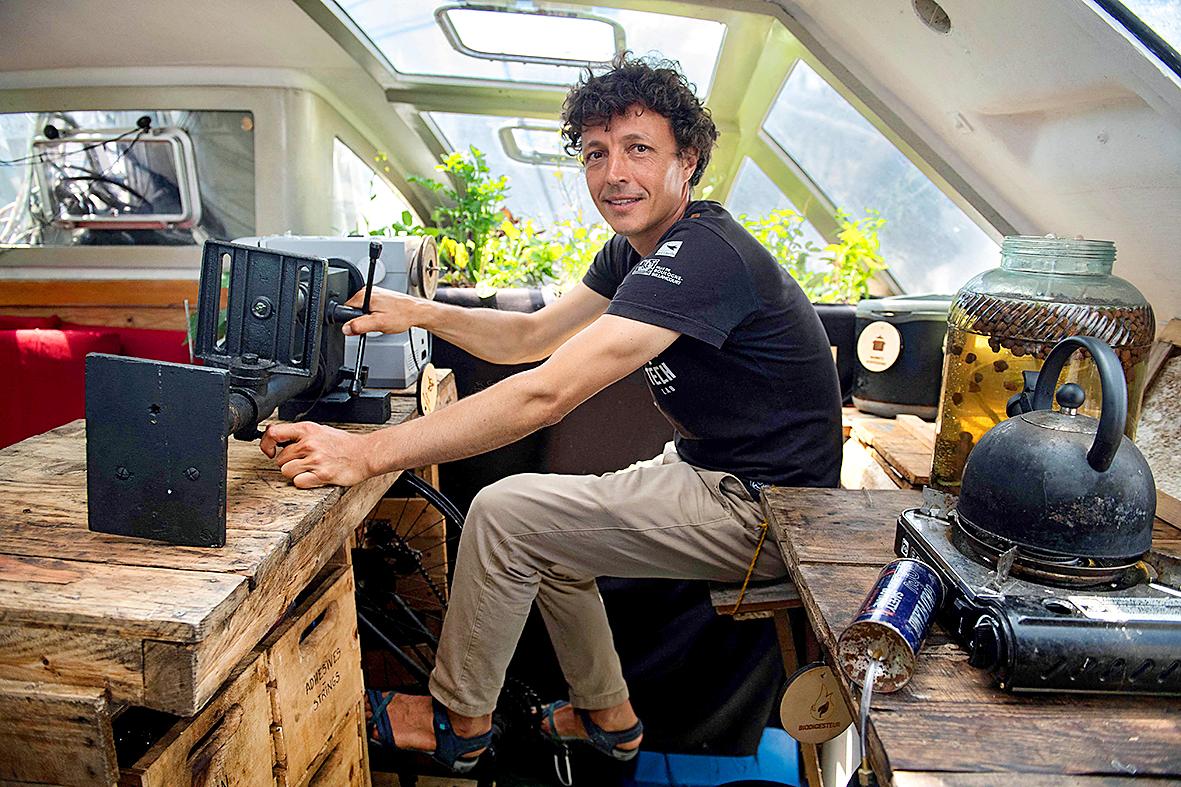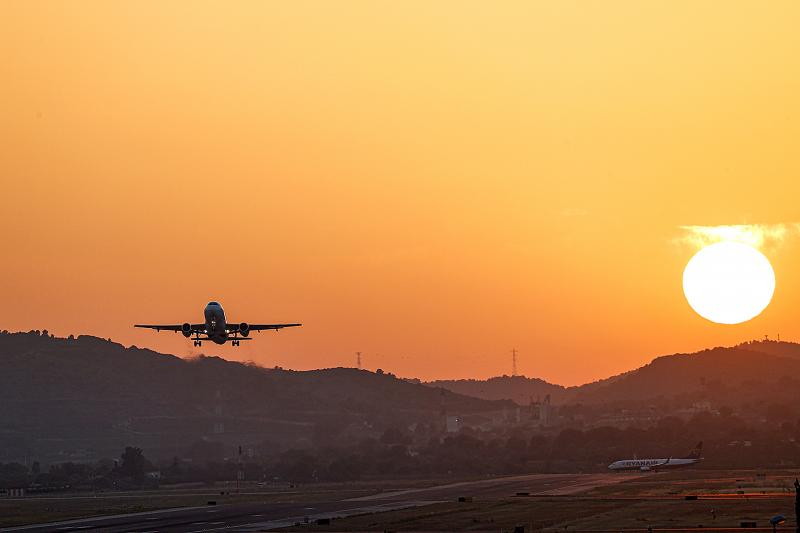Sitting on the terrace of a cafe in the heart of Lisbon one morning last month, sales specialist Victor Soto was busy at work communicating with colleagues across Europe and the Americas.
The COVID-19 pandemic is what drove the British-Peruvian 33-year-old to become a so-called “digital nomad.”
“The lifestyle gives me a lot of choice and freedom,” he said.

Photo: AFP
Soto made the decision to work only for companies that offer fully remote working in order to fulfill his passion for travel, he explained.
Soto is now also part of a growing trend among digital nomads who are looking for a less frenetic pace of life.
These new “slomads” still travel around the globe taking their work with them, but are choosing to spend longer in one location — some to enjoy a richer cultural experience while others are driven by the desire to be more eco-conscious.

Photo: AFP
Remote and flexible working has boomed since coronavirus lockdowns lifted globally, backed by major companies from AirBnB to Twitter and a rising number of nations issuing digital nomad visas which allow people to stay and work for up to two years.
The typical profile of a digital nomad is shifting, as island-hopping 20-somethings are joined by online workers in their 30s and 40s travelling with partners and children, experts and researchers say.
But concerns are growing over their environmental impact.

Photo: EPA-EFE
While data is scarce on the carbon footprint of digital nomads, “slomads” are striving to fly less, stay in sustainable accommodation, and invest in, or contribute to, green projects.
However, climate campaigners are not convinced, saying the social phenomenon still depends on air travel, which produces up to 3 percent of global greenhouse gas emissions.
“I think we feel a bit guilty, because the main issue with this lifestyle is the flying,” said Emmanuel Guisset, a former digital nomad who is now chief executive of Outsite, which offers co-living spaces for people including remote workers.
SLOWING DOWN
Pre-pandemic, the stereotype of a digital nomad was a freelancer in their 20s bouncing between sunny locales and sporting little more than shorts, flip-flops and a laptop.
Now, more people are combining work with travel later in life — often staying longer in one place to benefit from cheaper rents and better appreciating and contributing to local culture.
A poll published in May by freelancer marketplace Fiverr and travel guide publisher Lonely Planet showed one-third of nomads surveyed moving every one to three months, while 55 percent enjoyed working in one location and moving after three months or more.
Americans make up the majority of digital nomads. A 2021 study from Upwork on the habits of hiring managers estimated that 36.2 million US citizens would work remotely by 2025, an 87 percent increase from pre-pandemic levels. Tourist hot-spots have been quick to embrace digital nomads, and view the growing trend of remaining longer in one location as a way to recoup losses from pandemic lockdowns.
Destinations such as Aruba, Barbados, Cape Verde, Croatia, Estonia, Indonesia, Malta and Norway have created digital nomad visas, allowing people to stay put and work for up to two years.
Accommodation rental company AirBnB saw a 90 percent rise in long-term bookings in Portugal last year compared to 2019, which it said reflected how more people are taking advantage of the ability to work and live from anywhere.
Yet digital nomads admit there is still a lot of flying involved, especially since the easing of COVID-19 restrictions, although experts say it is difficult to identify nomads’ share of flights compared with tourism and business passengers.
Denise Auclair, corporate aviation expert at European clean transport campaign group, Transport and Environment (T&E), said there was “a golden opportunity” to continue with the reduced level of business travel seen during the pandemic, and to cut down on unnecessary flying.
But she queried whether companies are factoring the carbon footprint of employees working as digital nomads into their annual emissions reports.
Guisset of Outside said nomads are increasingly turning to carbon offsets, whereby people seek to compensate their climate impact by funding projects that reduce emissions through activities such as planting trees.
Some environmental groups, however, have dismissed such carbon-credit schemes as “window dressing.”
“It gives people a false sense of flying green, when there are so many problems with it,” said Dewi Zloch, aviation expert at Greenpeace Netherlands.
She pointed to research done for the European Commission in 2017 that said carbon-offsetting schemes are not providing real and measurable emissions reductions.
GREEN LIVING
The pandemic-driven remote work boom, meanwhile, has encouraged the creation of co-living and co-working spaces, some of which are trying to put green ideas into practice.
When Outside first started with its California co-living property, the company planted a tree for each booking made in locations from the Andes mountains to Indonesia.
Traditional Dream Factory, a co-living space in Portugal’s vast rural Alentejo region which plans to launch next summer, is trying something more ambitious.
Co-founder Samuel Delesque said the aim is to set up a community of like-minded digital nomads, engineers, artists and crypto entrepreneurs who will also regenerate the land.
The organization has already started covering deforested areas with nitrogen-fixing crops and planted hundreds of trees.
It also plans to insulate its living quarters and create natural pools and showers to save water and become self-sufficient.
A former software engineer and digital nomad, Delesque plans to expand in countries like South Africa and the US.
Caring for the environment is at the heart of his project, the Franco-Danish entrepreneur said.
“If we don’t manage to align economic values with (the) ecological, then we’re really doomed as a species,” he added.

On April 26, The Lancet published a letter from two doctors at Taichung-based China Medical University Hospital (CMUH) warning that “Taiwan’s Health Care System is on the Brink of Collapse.” The authors said that “Years of policy inaction and mismanagement of resources have led to the National Health Insurance system operating under unsustainable conditions.” The pushback was immediate. Errors in the paper were quickly identified and publicized, to discredit the authors (the hospital apologized). CNA reported that CMUH said the letter described Taiwan in 2021 as having 62 nurses per 10,000 people, when the correct number was 78 nurses per 10,000

As Donald Trump’s executive order in March led to the shuttering of Voice of America (VOA) — the global broadcaster whose roots date back to the fight against Nazi propaganda — he quickly attracted support from figures not used to aligning themselves with any US administration. Trump had ordered the US Agency for Global Media, the federal agency that funds VOA and other groups promoting independent journalism overseas, to be “eliminated to the maximum extent consistent with applicable law.” The decision suddenly halted programming in 49 languages to more than 425 million people. In Moscow, Margarita Simonyan, the hardline editor-in-chief of the

Six weeks before I embarked on a research mission in Kyoto, I was sitting alone at a bar counter in Melbourne. Next to me, a woman was bragging loudly to a friend: She, too, was heading to Kyoto, I quickly discerned. Except her trip was in four months. And she’d just pulled an all-nighter booking restaurant reservations. As I snooped on the conversation, I broke out in a sweat, panicking because I’d yet to secure a single table. Then I remembered: Eating well in Japan is absolutely not something to lose sleep over. It’s true that the best-known institutions book up faster

Though the total area of Penghu isn’t that large, exploring all of it — including its numerous outlying islands — could easily take a couple of weeks. The most remote township accessible by road from Magong City (馬公市) is Siyu (西嶼鄉), and this place alone deserves at least two days to fully appreciate. Whether it’s beaches, architecture, museums, snacks, sunrises or sunsets that attract you, Siyu has something for everyone. Though only 5km from Magong by sea, no ferry service currently exists and it must be reached by a long circuitous route around the main island of Penghu, with the